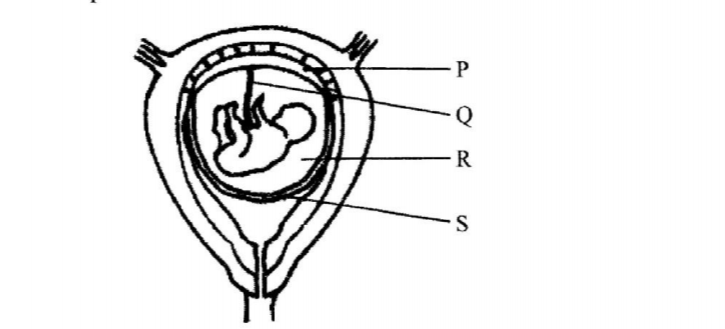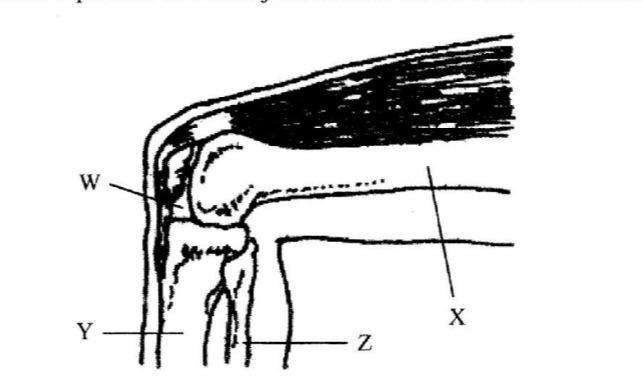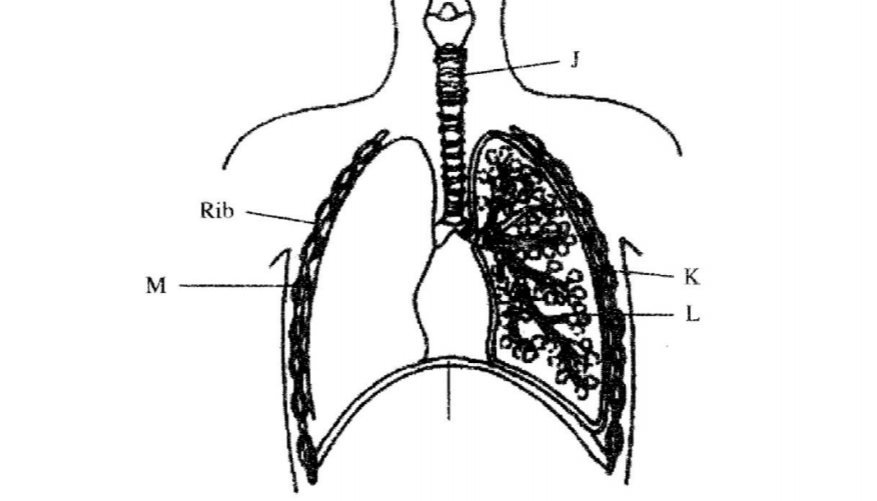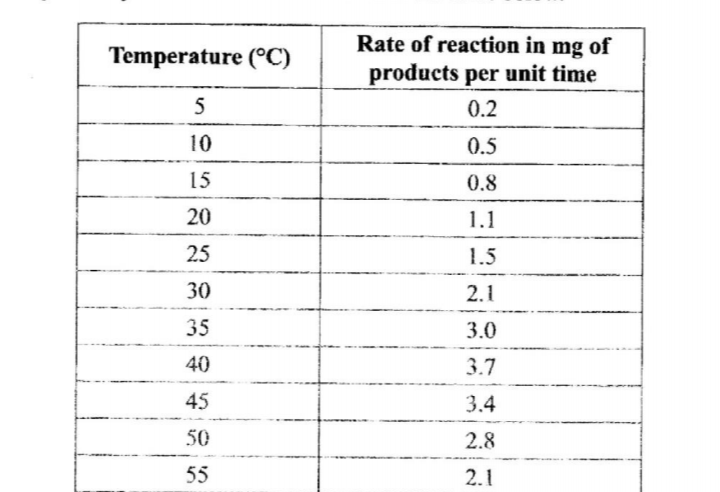2016 Biology Paper 2
KCSE Past Papers 2016 Biology Paper 2
(a) Name the bones labeled X, Y and Z (3 marks) X: Y:
(a) Name the structures labeled K, L and M. (3 marks)
(a) Account tbr the appearance of the pieces in solutions L. and L2. (6 marks)
(a) On the grid provided plot the rate of reaction against temperature. (6 marks)
(b) When was the rate of reaction 2.6 mg of product per unit time? (2 marks)
(a) Name the structures labeled K, L, and M . (3 marks)
(a)Account for the appearance of the pieces in solutions Ll and L2 (6 marks)
2016 Biology Paper 2
1. The diagram below represents a human foetus in a uterus.
(a) Name the part labeled S. (1 mark)
(h) (i) Name the types of blood vessels found in the structure labeled Q. (2 marks)
(ii) State the difference in composition of blood found in the vessels named in
(b) (i) above. (2 marks)
(c) Name two features that enable the structure labeled P to carry out its function. (2 marks)
(d) State the role of the part labeled R. (1 mark)
2. (a) How is sex determined in man? (4 marks)
(b) (i) Differentiate between sickle cell anaemia and sickle cell trait. (2 marks)
(ii) Explain why people with sickle cell trait have an adaption survival advantage over normal individuals in malaria endemic regions. (2 marks)
3. The diagram below represents bones at a joint found in the hind limb of a mammal.
(b) (i) Name the substance found in the place labeled W. (I mark)
(ii) State the function of the substance named in (b) (i) above. (1 mark)
(c) Name the structure that joins bones together at the joint. (I mark)
(d) State the difference between ball and socket joint and the one illustrated in the diagram aboNe. (1 mark)
(e) Name the structure at the elbow that performs the same function as the patella. (1 mark)
4. The diagram below represents some gaseous exchange structures in humans.
(b) How is the structure labeled J suited to its function? (3 marks)
(c) Name the process by which inhaled air moves from the structure labeled L into blood capillaries. ( I mark)
(d) Give the scientific name of the organism that causes tuberculosis in human (1 mark)
5. A freshly obtained dandelion stern measuring 5cm long was split lengthwise to obtain two similar pieces.
The pieces were placed in two different solutions of different concentrations in petri dishes (L. and L2) for 20 minutes. The appearance after 20 minutes is as shown.
(b) State the significance of the biological process involved in the experiment. (2 marks)
SECTION B (40 marks)
Answer question 6 (compulsory) and either question 7 or 8 in the spaces provided after question 8.
6. An experiment was carried out to investigate the effect of temperature on the rate of reaction catalysed by an enzyme. The results are shown in the table below.
(c) Account for the shape of the graph between:
(i) 5°C and 40°C (2 marks)
(ii) 45°C and 60°C (3 marks)
(d) Other than temperature name two ways in which the rate of reaction between 5°C and 40°C could be increased. (2 marks)
(e) (i) Name one digestive enzyme in the human body which works best in acidic condition. (1 mark)
(ii) How is the acidic condition for the enzyme named in
(c) (i) above attained? (2 marks)
10 (f) The acidic condition in
(e) (iii) above is later neutralized.
(i) Where does the neutralization take place? (1 mark)
(ii) Name the substance responsible for the neutralization. (1 mark)
7. Using a relevant example in each case, describe simple and conditional reflex actions. (20 marks)
8. Describe how the mammalian heart is structurally adapted to its function. (20 marks)
Questions and answers
Biology Paper 2 (231/2)
No. 1 a) Name the part labeled S. (1 mark)
❖ Chorion
b) (i) Name the types of blood vessels found in the structure labeled Q. (2 marks)
❖ Arteries; veins
(ii) State the differences in composition of blood found in the vessels named in (b)(i)above. (2 marks)
❖ More food nutrients; more oxygen in veins less food nutrients more excretory products in arteries
( c) Name two features that enable the structure labeled P carry out its function. (2 marks)
❖ Highly vascularized; large surface area
❖ Presence of secretory cells
(d) State the role of the part labeled R (1 mark)
❖ Cushion/ absorb shock
No. 2. (a) How is sex determined in man? (4 marks)
❖ Males have two dissimilar chromosomes X and y/ heterogametic;
❖ Females have two similar chromosomes X and X/ homogametic;
❖ Male gamete/ sperms have either X or y chromosome, while all ova have X chromosome;
❖ if a sperm with X fuses with an ovum a female is formed and if a sperm with Y fuses with an ovum a male is formed;
(b) (i) Differentiate between sickle cell anaemia and sickle cell trait. (2 marks)
❖ Sickle-cell trait is heterozygous while sickle cell anaemia is a homozygous condition
(ii) Explain why people with sickle cell trait have an adaptive survival advantage over normal individuals in malaria endemic regions. (2 marks)
❖ People with sickle cell trait are resistant to malaria; because the plasmodium cannot survive in sickle shaped red blood cells; rej thrive for survive
No. 3.(f) Name the bones labeled X,Y, and Z (3 marks)
❖ X- Femur
❖ Y- Tibia
❖ Z- Fibula
(g) (i) Name the substance found in the place labeled W. (1 mark)
❖ Synovial fluid
(g) (i) Name the substance found in the place labeled W. (1 mark)
❖Synovial fluid
(ii) State the function of the substance named in (b) (i) above (1 mark)
❖ Lubrication of the joint/ shock absorption ❖ Distribution of pressure
(h) Name the structure that joins the bones together at the joint. (1 mark)
❖Ligament
(i) State the differences between ball and socket joint and the one illustrated in the diagram above. (1 mark)
❖ Ball and socket joint allows movement in all planes while the illustrated allows movement in one plane only. Accept 360° for all planes 180° for one plane
(j) Name the structure at the elbow that performs the same function as the same function as the patella. (1 mark)
❖Olecranon process
No. 4. The diagram below represents some gaseous exchange structures in humans.
❖K- Pleural membranes
❖ L- Alveolus
❖ M- Intercostal muscles
(b) How the structure labeled J is suited to its function? (3 marks)
❖ Has C- shaped cartilage rings that support it preventing it from collapsing and allow free flow of air
❖ Inner lining has mucus secreting cells that trap fine dust particles and micro-organisms
❖ Inner lining has hair like structures called cilia that enhance upward movement of the mucus to the larynx
(c) Name the process by which inhaled air moves from the structure labeled L into blood capillaries (1 mark)
❖ Diffusion
(d) Give the scientific name of the organism that causes tuberculosis in humans (1 mark)
❖ Mycobacterium tuberculosis (underline separately). Reject if not done so.
No. 5. A freshly obtained dandelion stem measuring 5 cm long was split lengthwise to obtain two similar pieces. The pieces were placed in solutions of different concentrations in petri dishes (L.1 and L2) for 20 minutes. The appearance after 20 minutes is as shown
❖ Li - Inner cells gained water by Osmosis; hence increased in length; epidermal cells did not gain water because they are covered by a water proof cuticle leading to curvature.
❖ L2 - Inner cells lost water by osmosis; leading to (flaccidity) decrease in length; epidermal cells did not lose water due to waterproof leading to curvature
(b)State the significance of the biological process involved in the experiment (2 marks)
❖ Absorption of water by the roots
❖ Opening and closing of the stomata
(b) When was the rate of reaction 2.6 mg of product per unit time? (2 marks)
❖ 33°C and 51.5 (± 0.5°C)
❖ 32.5 - 33.5 and 51.0 - 52.0
(c) Account for the shape of the graph between (i) 5°C and 40° C (2 marks)
❖ As temperature is increased rate of reaction is increased/ more products are formed (per unit time) because enzymes become more active
(ii) 45° C and 60° C (3 marks)
❖ As temperature increase rate of reaction decreases less/ products are formed (unit per time) because enzymes become denatured by high temperatures above 40°, hence cannot act on substrate.
(d) Other than temperature name two ways in which the rate of reaction between 5°C and 40°C could be increased. (2 marks)
❖ Increase in enzyme and substance concentration
❖ Use of cofactors and co-enxymes
(e) (i) Name one digestive enzyme in the human body which works best in acidic condition. (1 mark)
❖ Pepsin,
❖ Chymosin
❖ Renin
(ii) How is the acidic condition for the enzyme named in (e)
(i) above attained? (2 marks)
❖ Wall of stomach/ gastric gland/ oxyntic/ pariental/ cell produced Hydrochloric
(f) The acidic conditions in (e) (ii) above is later neutralized (i) Where does the neutralization take place? (1 mark)
❖ Duodenum
(ii) Name the substance responsible for neutralization. (1 mark)
❖ Bile juice/ e.g. NaHCO3
No. 7. Using a relevant example in each case, describe simple and conditional reflex actions.(20 marks)
❖ Simple reflex action eg. withdrawal of finger from a sharp object/ hot object; its an automatic response to a specific stimulus; when the finger touches sharp object/ hot object, the pain receptors/ thermoreceptors in the skin are stimulants; and trigger off a nerve impulse; the nerve impulse is transmitted via the senses neurone; to the grey matter of the spinal cord/ CNS/ brain; the impulse is then transmitted via synapse; to the relay neurone; and then through another synapse; to the motor neurone; and then through another synapse; to the motor neurone; the impulse is then transmitted to the effector muscles in the hand; ace - efferent neurone for motor neurone
❖ Afferent neurone for sense neurone
❖ intermediate/ associative/ connector/ interauncial neurone - for relay. The effector muscles/ biceps contract; and the finger is withdrawn from the hot object/ sharp object; conditioned reflex action - salivation in a dog/ human being (ace. any other relevant example) student in response to sound; it is an automatic response evoked from an animal by unrelated stimulus; substituted for the one which normally elicits the response; it develops from a past experience; and involves modification of behaviour/ involves learning; it weakens with time; and must be reinforced by repeating the related stimulus; the dog/ student salivates when the bell (for meals) rings; because they have learnt to associate the ringing of the bell at meal time with food; everytime it rings (accept use of other relevant examples) they are offered food.
No. 8.Describe how a mammalian heart is structurally adapted to its function.(20 marks)
❖ Cardiac muscles which contract and relax continually without fatigue/ myogenic
❖ Cardiac muscles are interconnected / a synclination form of network offibres to rapidly and uniformly spread the contractions
❖ Divided into four chambers for Atria to receive blood and ventricles to pump blood out of the heart
❖ Divided into two sides by a longitudinal septum to prevent mixing of oxygenated and deoxygenated blood / for double circulation
❖ Ventricles have thicker walls to generate high prevention pressure to pump blood
❖ Wall of the left ventricle is thicker than that of right ventricle to pump blood over a long distance.
❖ Have valves to prevent back flow of blood
❖ Cuspid valves have strands of connective tissues / tendinious codes / valve tendons to prevent turning in/ out during systole / when ventricles contract
❖ Has coronary artery to nourish / supply oxygen to the heart/ muscles; has a coronary vein to remove metabolic wastes carbon(iv)oxide
❖ Enclosed by a pericardium to keep it in position / prevent over dilation
❖ Pericardium secretes pericardial fluid to reduce friction / absorbs shock
❖ Has Sino Artrio Node (SAN) which acts as a pacemaker
❖ Has Atrio Ventricular Node (AVN) which relays contraction waves from SAN to the puncinje tissues
❖ Has puncinje tissue / bundle of HIS to relay waves from AVN to the ventricular myocardium
❖ Cardiac muscles have numerous mitochondria to generate energy for the muscular contractions
❖ Has venacava and pulmonary vein to supply blood to the heart.
❖ Has aorta and pulmonary artery to transport blood away from the heart.








Did you hear there is a 12 word sentence you can say to your crush... that will induce deep emotions of love and impulsive attractiveness for you deep within his heart?
ReplyDeleteBecause hidden in these 12 words is a "secret signal" that fuels a man's instinct to love, treasure and look after you with all his heart...
12 Words Will Fuel A Man's Love Response
This instinct is so built-in to a man's mind that it will make him work harder than ever before to love and admire you.
Matter-of-fact, fueling this influential instinct is so binding to getting the best ever relationship with your man that the instance you send your man one of the "Secret Signals"...
...You'll immediately find him open his heart and mind for you in a way he never expressed before and he'll perceive you as the one and only woman in the universe who has ever truly interested him.